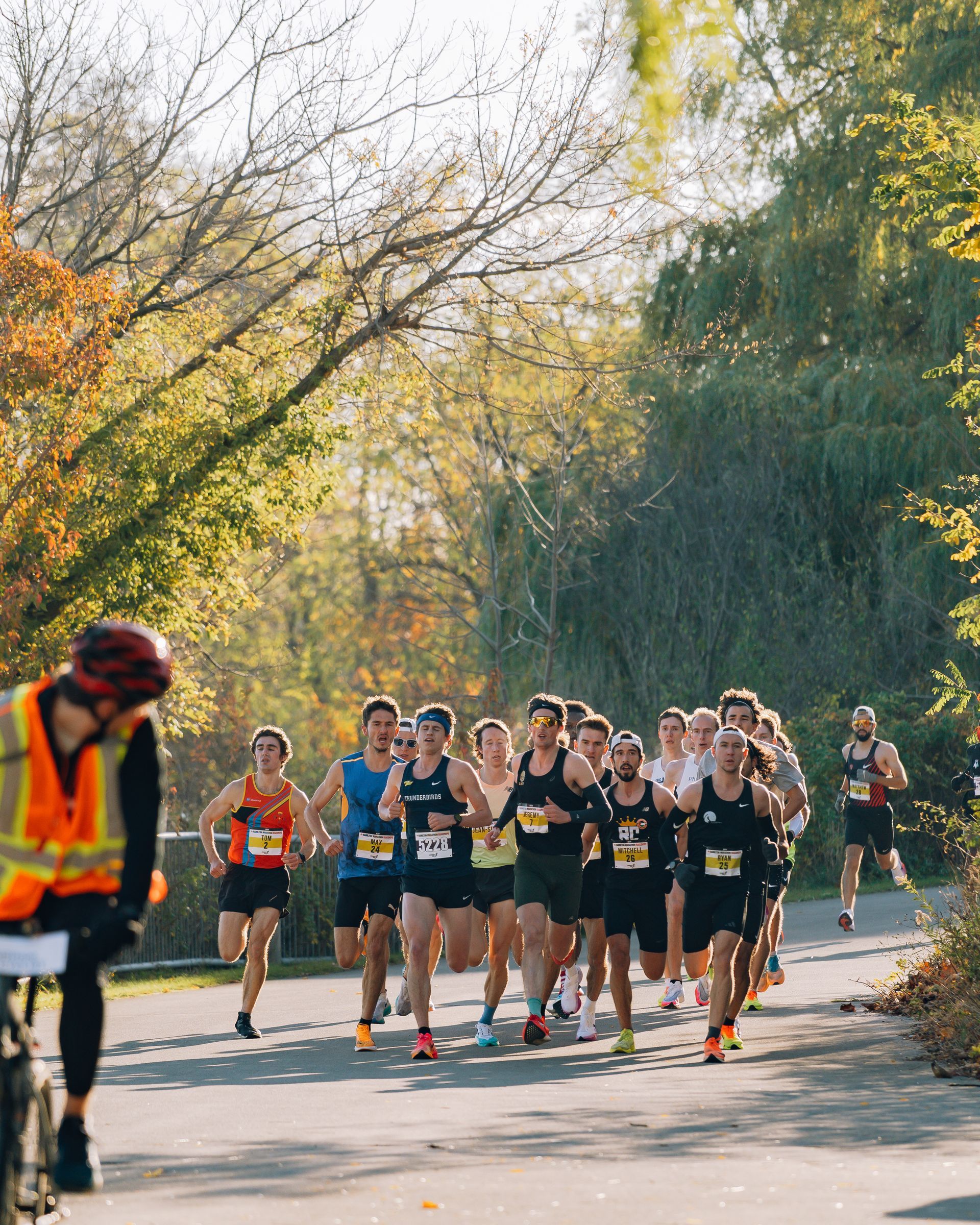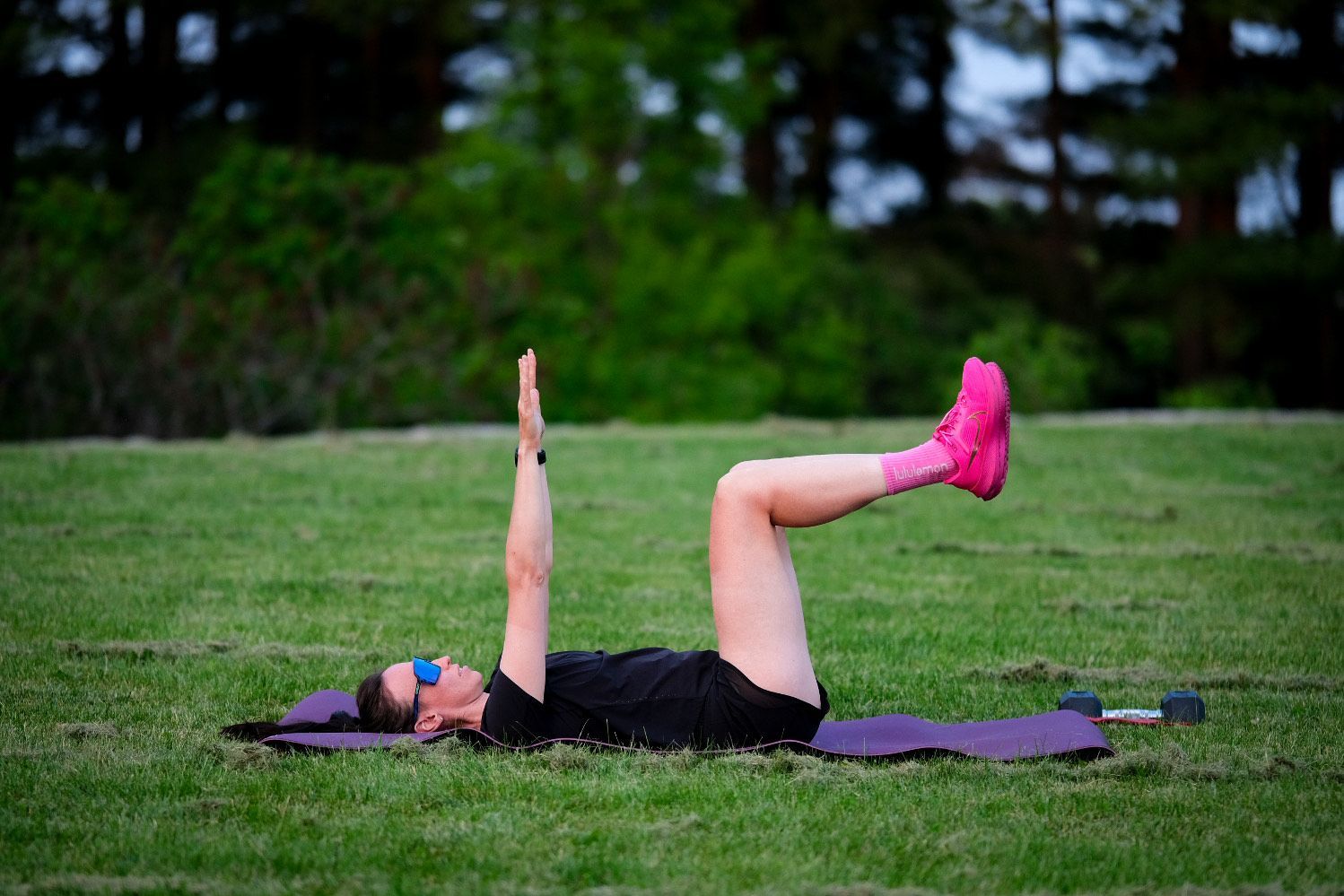#CoachMartin Blog

Welcome to the Journey If you’re reading this, you’ve got your eye on one of Ontario’s toughest and most rewarding trail races — the Sulphur Springs Trail Race, now a Western States qualifier. Whether you’re gearing up for 50K, 50 miles, 100K, or the full 100 miles, I want to help you arrive ready, strong, healthy, and confident. I know this race inside out. Last year, I managed one of the aid stations at the bottom of Martin Road, and coached multiple athletes who crossed those finish lines from 50K all the way to 100 miles. Every one of them finished. That’s not luck, that’s smart training, grit, and commitment. And I didn’t just watch it happen, I paced one of my athletes through her final 26 km, bringing her to her 100-mile buckle finish. Watching her dig deep and fight through those final loops was one of the most powerful coaching moments of my life. If you’re ready to train with purpose, this guide will show you how to build toward your best Sulphur Springs yet. Why Sulphur Springs Trail Race Deserves Your Respect Sulphur Springs isn’t just another ultra. It’s history, community, and pure challenge wrapped into one. Here’s why it’s special: 20 km loop course through the Dundas Valley Conservation Area, featuring singletrack, forest canopy, and punchy climbs. Each loop delivers roughly 500 m of elevation gain and it adds up fast. It’s Ontario’s oldest ultra, running since the early 1990s, and it shows in the atmosphere and volunteer spirit. 100K and 100-mile finishes under cutoff earn you a Western States ballot, making this Ontario’s only WSER-qualifying event. If you want to test yourself, this is the place to do it. What It Takes to Train for 100 Miles Training for Sulphur Springs, or any ultra, means blending science, structure, and heart. You’re not just logging miles. You’re building durability, learning how to manage fatigue, and training your brain as much as your body. Here’s the roadmap: 1️⃣ The Timeline If your goal is 100K or 100 miles, expect 10–13 months of structured preparation. That gives you enough time for base, build, peak, taper, and recovery. Phases look like this: Base/Foundation (12–16 weeks): Aerobic strength, movement quality, and consistency. Build (12–16 weeks): Volume, long runs, back-to-backs, trail exposure. Peak (8–12 weeks): Race simulation, fatigue training, terrain work. Taper (2–4 weeks): Reduce volume, stay sharp, arrive fresh. If you’re already running 50–70 km weekly, I can compress the timeline while maintaining recovery and safety. 2️⃣ Weekly Mileage & Long Runs Mileage peaks vary by athlete, but here’s what’s common for 100-mile prep on Ontario trails: Base: 50–70 km/week Build: 90–140 km/week Peak: 160–200+ km/week Long runs: 40–60 km or more, often back-to-back weekends Smart training isn’t about chasing numbers. It’s about stacking quality weeks and staying healthy. 3️⃣ Train for the Terrain Sulphur Springs will test your climbing, descending, and patience especially on sections like Martin Road and the escarpment trails. You’ll need hill work (up and down), technical trail exposure, and specific strength to handle the repeated loops. If you can train on course terrain, perfect. If not, I’ll guide you on how to simulate it effectively. 4️⃣ Back-to-Back Long Runs A core element of ultra prep. Back-to-backs build fatigue resistance, fueling rhythm, and mental durability. Example: 40 km Saturday + 30 km Sunday both controlled, intentional, and strategic. These sessions teach your legs and brain how to perform under cumulative fatigue. 5️⃣ Strength, Mobility & Durability Running alone won’t carry you 100 miles. You need a body that can handle the miles. That’s why I integrate: Strength and stability work Single-leg training Mobility and injury prevention drills Core and glute activation This isn’t optional, it’s what keeps you healthy and powerful all season. 6️⃣ Nutrition & Gut Training You can’t fake fueling. You have to train your gut just like you train your legs. We’ll test what works gels, solids, salts, fluids and dial in your intake by time and effort. You’ll simulate race-day nutrition on long runs and learn how to manage your energy over 12–24+ hours of movement. 7️⃣ Pacing & Mental Game No 100-mile race goes perfectly. You’ll hit walls, and that’s okay. The key is pacing control, energy management, and mental resilience. We’ll plan loop strategies, pacing windows, and mental cues to carry you through those dark patches. From Aid Station to Finish Line — What I Saw Last year, I witnessed something special. Athletes I coached started that race with massive goals and finished with pride, exhaustion, and pure joy. Every single one crossed under their own power because we built their training right: foundation, volume, strength, fueling, and mindset. And pacing my athlete through those final 26 km to her 100-mile buckle… that changed me as a coach. It reminded me why I do this, to help people push beyond what they thought possible. Why Train With Me Here’s what I deliver when you join my program: ✅ Custom programming built for your schedule, goals, and body. ✅ Holistic coaching run training, strength, mobility, fueling, recovery, mindset. ✅ Hands-on support: I check in, adjust, and coach you through every phase. ✅ Community of trail runners, strength athletes, and real people chasing big goals. ✅ Proven results for 50K, 100K, 50M, 100M finishers. ✅ Passion & integrity, I live this sport and coach it with heart. Ready to get started? Visit coachmartin.ca for a free consult and let’s build your ultra plan. Start Building Now Here’s how you can start preparing today: Run 3–5x per week (build up to 50–70 km/week). Strength train 2x weekly. Add hill work weekly (both up and down). Practice fueling on long runs. Add back-to-back runs (even short ones). Study the course and visualize your loops. Join trail groups and connect with others training for SSTR. By fall, you are building your base. By spring, you’re peaking. By May you’re ready to take on Sulphur Springs. Final Word: Let’s Do This Together Sulphur Springs will test every part of you, physically and mentally. But it will also give you one of the most powerful experiences of your life. Loop by loop, aid station by aid station, you’ll learn what you’re truly capable of. When you cross that finish line buckle in hand, heart full, it will all make sense. Let’s get you there. Visit coachmartin.ca and let’s start your Sulphur journey together. See you on the trails. Martin

It’s late August, which means you have about ten weeks until Hamilton’s Road2Hope race weekend (Saturday, November 1 for the 1K/5K/10K; Sunday, November 2 for the half and full marathon, 8:00 a.m. start). Both longer races start and finish in Confederation Park on a flat, fast, waterfront route. This is a great hometown race, with many of the runners, sponsors, and volunteers hailing from Hamilton and the surrounding areas. It’s a personal favourite of mine, mostly because it’s one of the friendliest road races around, and for that reason alone, a great first half- or full marathon. The route will be familiar to local runners, and the shirts and finisher medals are always a source of pride. But the gold, silver, and bronze in this race go to the runners with excellent pacing discipline and strong aerobic conditioning. Whether you’re in it to win it or you just want to finish your first big race, the Road2Hope is a great event to start with. Why start now Ten weeks is enough time to arrive ready, especially if you’ve already been running for a while. Ad structure by following a plan that emphasizes mostly easy running, a small amount of purposeful faster work, and steady long-run progression. After all, you don’t want ot overtrain. Science shows that endurance athletes tend to respond best when the majority of training is kept at a low intensity, with limited, well-placed high-intensity sessions. This approach will help you improve your overall fitness without carrying chronic fatigue into race day. How I coach You won’t get a cookie-cutter PDF from me -- you’ll get an individualized plan that’s uniquely yours. We begin with your current mileage, available training days, and background, then build a progression that fits your real life. It’s also likely you’ll be spending some time in the gym: We include strength work in the plan because it improves running economy and durability for so many runners. We adjust the week if and when life intervenes, so you can maintain momentum instead of starting over. Your 10-week build (starting week of August 25) Below is a sample plan. It explains what we do in each phase and why it works. If your current weekly mileage is very low, we’ll target the half this year (or a Saturday 10K) and use the same structure with smaller volumes, setting you up for a spring marathon. Weeks 1–2: Reboot and aerobic base We establish a reliable routine of mostly easy running with short strides (8–10 seconds, full recovery) and two brief strength sessions per week. The easy volume rebuilds your aerobic engine, the strides reintroduce leg speed without stress, and the strength work begins improving running economy through neuromuscular adaptations. Long runs are comfortable and unhurried (typically 12–14 km for half-marathoners and 18–22 km for marathoners), so you finish feeling like you could do more. This balance lets you recover between days while accumulating the kind of work that actually moves fitness forward. Weeks 3–5: Threshold development and hill economy We add one focused workout each week, for example, steady threshold running or aerobic intervals, and keep one long run that we add distance to gradually over time. Threshold efforts improve your ability to clear and tolerate lactate so your target pace feels easier, while short hill repetitions reinforce mechanics and strength specific to running. Long runs begin to include brief segments at planned race effort so you can practice fueling, pacing, and form under light fatigue without overreaching. This phase builds confidence while preserving the mostly-easy backbone that supports consistent training. Weeks 6–7: Specific preparation and peak stimulus In this phase, we combine longer tempo blocks with race-pace segments inside the long run to simulate the demands of a flat, steady course like the Road2Hope . Half-marathoners might complete an 18–21 km long run with 8–10 km at goal pace; marathoners might run 30–34 km with the final 10–12 km near marathon effort. These sessions teach even pacing and late-run focus—the exact skills the Road2Hope course rewards—while the rest of the week stays predominantly easy so you absorb the work. Strength training stays in but shifts to maintenance to preserve freshness. Weeks 8–9: Taper while keeping your edge With the race just a few weeks out, we deliberately reduce weekly volume while keeping short, familiar doses of intensity. The goal is to remove accumulated fatigue without losing the adaptations you’ve built. Research on tapering supports maintaining intensity, trimming volume substantially, and only slightly reducing frequency; this strategy reliably improves endurance performance across taper lengths of about one to three weeks. Practically, you’ll feel your legs come back while workouts remain snappy but brief. Week 10: Race week routine It’s race week: Time to finalize pacing and logistics. We’ll keep runs short with a few strides, and prioritize sleep, nutrition, and calm. Your fueling plan — which you’ll have tested in training — should supply 30–60 grams of carbohydrate per hour for most athletes in the half or a faster marathon, and up to ~90 grams per hour for marathons expected to last three hours or more. We’ll choose products you tolerate, practice timing, and pair carbs with fluids and electrolytes. This approach helps maintain blood glucose and delays fatigue so your late-race pace holds. Why we keep strength work in the plan Running performance is not just about the cardiovascular system; stronger muscles and tendons can make you more economical at a given pace. Multiple reviews and recent trials show that adding heavy resistance or explosive strength training two to three times per week over about 8–12 weeks can meaningfully improve running economy and time-trial performance, with benefits that persist when transitioned to lighter maintenance work in the final weeks. We use compound lifts (e.g., squats, deadlifts, step-ups) and single-leg stability to build resilience, and we taper the loads as race day approaches so your legs feel springy, not sore. How we fuel the training During the build, daily carbohydrate availability matters so you can complete key sessions and recover. Studies show that a higher carbohydrate intake during heavier training weeks, then race-specific fueling during long runs and tune-ups. (We’ll have worked on all of this so that you’re not trying anything new on race day.) Your nutrition , like the rest of your training plan, will be tailored to you, but the principle is simple: Arrive fueled for quality, replenish promptly afterward, and keep hydration and electrolytes consistent with conditions. Ready to train smarter? Training for Road2Hope is not about chasing heroic workouts; it’s about stacking the right sessions, week after week, and arriving on November 2 with strong legs and a calm mind. If you want a plan built around your history, your schedule, and this course — and a coach who will adjust it as life happens — apply to train with me. We’ll map your ten-week block to Road2Hope, practice what you’ll execute on the day, and help you finish strong. Get in touch. Register for the Road2Hope .

There’s more to injury prevention for runners than warming up and stretching. Strength training is essential to support muscles and joints, while potentially improving both speed and endurance. Whether you’re training for your first 5K or chasing an ultramarathon PR, running injury-free isn’t just about builidng up your endurance; it’s about how well your body is prepared to handle the load. Contrary to what you may have been told your whole life, there’s more to injury prevention than just warming up and cooling down. Shin splints, knee pain, hip tightness, weak core, and glute soreness are all common signs your body is compensating for underdeveloped strength or mobility. The solution is to train smart. Build the engine. And run with power, not pain. The best way to do that? Strength training . As a running and strength coach, I’ve worked with runners of all levels to develop strength programs that support sustainable progress. While the runners I work with all have individualized programs, the four movements below (or some variation of them) tend to make frequent appearnces in their training plans. These tried-and-true exercises aren’t complicated, but they yield powerful results. And by the way: You should ALWAYS warm up before you run and have a good stretch after ! In addition to strength training, your warmup and cooldown are essential to prevent injury! 1. Bulgarian Split Squats The Bulgarian Split Squat is a favourite among many coaches because it’s so simple, targeted and effective. Among other benefits, it helps ensure a runner’s legs are balanced in their strenth. It also sneaks in some core strengthening, which is more important than most runners realize. You may want to start without weight (it’s hard enough, trust me!) and then gradually add weights, starting with a dumbbell in each hand. Targets: Glutes, quads, hamstrings, hip stabilizers Addresses: Knee pain, glute weakness, imbalanced leg strength How to do it: Stand in front of a bench, back foot resting on it. Lower into a controlled lunge, keeping your front knee stable and your torso tall. Drive through the front heel to rise. 3 sets of 8–10 reps per leg. To add weight, hold dumbbells or kettlebells in each hand -- or try a barbell in front or back rack position. Watch this video for form tips. Why it matters : Corrects left-right imbalances and improves single-leg control, a must for protecting your knees and building a powerful stride. Long-term win : Fewer overuse injuries, stronger drive, more efficient running. 2. Dead Bugs Tired of ab crunches? Dead bugs are more effective and much easier on your neck too. The key to getting the most of out of this exercise is to focus on keeping your lower back pressed into the floor throughout the movement. It’s more challenging than you think, but you’ll probably still dread it less than crunches or planks! Targets: Deep core, hip flexors, lumbar stability Addresses : Core weakness, posture issues, hip tightness How to do it: Lie on your back, knees bent at 90°, arms up. Lower your opposite arm and leg slowly while bracing your core. Alternate sides with control. 3 sets of 10–12 reps each side. Watch this video for form tips. Why it matters: Builds deep core strength, reinforces spinal stability, and prevents pelvis collapse during long runs. Long-term win : Less lower back stress, smoother stride, improved posture. 3. Single-Leg Glute Bridges No one loves glute bridges , I know! But there’s a reason you dislike them: they burn. But that burning? It means they’re working, building stronger glutes -- and stronger glutes can prevent everything from IT band syndrome to painful knee injuries. The benefits are so numerous, you may even start to embrace the burn and love bridges! Targets : Glute max, hamstrings, posterior chain Addresses : Glute under-activation, hamstring strain, hip extension deficits How to do it: Lie down with one leg bent and the other extended. Drive through the bent heel to lift your hips. Keep the extended leg in line and squeeze the glute at the top. 3 sets of 10 reps per leg. Watch this video for form tips . Why it matters: Activates your glutes to do their job so other muscles don’t compensate. Reinforces power and proper hip extension mechanics. Long-term win : Better propulsion, reduced injury risk, stronger finishes. 4. Lateral Band Walks (Monster Walks) Lateral band walks may look funny, but they’re an excellent and simple way to build hip and knee stability and strengthen your gluteus medius and abductors. You can add weight to these, too! Once you’ve got the movement down, try holding a pair of dumbbells in front rack position, or get a goblet hold on a kettlebell. Targets : Glute medius, hip abductors Addresses: IT band pain, poor knee tracking, hip instability How to do it: Place a resistance band above your knees or at your ankles. Drop into a shallow squat and step sideways with control. 10 steps each way = 1 set. Complete 2–3 sets. Get form tips and watch a video here . Why it matters: Builds lateral hip strength and protects your knees from collapsing inward, a leading cause of runner’s knee and ITB pain. Long-term win : Better stability, safer stride, more confidence on uneven terrain. Build Smarter. Run Stronger. Train with Purpose. If you’re ready to stop guessing and start training like a runner built for the long haul, I’m here to help. My training programs don’t just include a schedule of runs, they’re designed with targeted strength training programs tailored or each unique athlete. While most programs include leg work, upper body, and core, each is personalized so that every runner can run stronger, with confidence -- and without injury. And if runners are injured and unable to run, we focus on strength and what we CAN do. I will often work with a runner’s physiotherapist or sport therapist’s recommendations to make sure my athletes return to running stronger and more resilient than they were before their injury. As a running and strength coach, my goal is to create individualized plans that develop the strength, mobility, and movement mechanics you need to perform consistently, whether you are racing, running for fun, or just beginning your fitness journey. 👉 Visit CoachMartin.ca to learn more or to book a consultation.

Fueling for Runners: The Balance Between Underfueling, Overfueling, and Optimal Performance When it comes to running performance, endurance, and recovery, nutrition is everything. Fueling properly before, during, and after a run can be the difference between hitting a new personal best -- or hitting the wall. However, many runners struggle to find the right balance. Some underfuel, leaving their bodies depleted and struggling to perform , while others overfuel , leading to sluggishness, GI distress, and poor energy utilization. So, what’s the key to optimal fueling? It’s about understanding: ✔️ The importance of proper fueling ✔️ The dangers of underfueling ✔️ The pitfalls of overfueling ✔️ How to fuel correctly for different race distances ✔️ How I incorporate fueling strategies into my coaching at CoachMartin.ca Why Proper Fueling Matters for Runners Running is demanding. Your body burns through carbohydrates, depletes glycogen , and requires protein for muscle repair. Fueling correctly ensures: ✅ Sustained energy levels to avoid crashes and fatigue ✅ Improved endurance, which keeps your muscles working efficiently ✅ Faster recovery, which supports muscle repair and glycogen replenishment ✅ Reduced risk of injury by strengthening the immune system and bones ✅ Better focus and performance, preventing mental fog and decision fatigue Yet, many runners struggle to fuel correctly, swinging between underfueling and overfueling, both of which can harm performance. The Dangers of Underfueling Underfueling happens when you don’t consume enough calories or carbohydrates to match your training demands. This can happen intentionally (fear of weight gain, avoiding GI issues) or unintentionally (not feeling hungry, forgetting to eat). Signs of underfueling include: ❌ Chronic fatigue, early burnout in runs ❌ Feeling weak or dizzy during or after workouts ❌ Poor recovery, lingering muscle soreness ❌ Increased risk of injury (stress fractures, tendinitis) ❌ Mental fog and lack of motivation ❌ Hormonal imbalances (missed menstrual cycles, low testosterone) Why It Happens: • Not eating enough before/during runs • Fear of weight gain or GI distress • Underestimating calorie needs • Busy schedules leading to skipped meals 🚨 The Pitfalls of Overfueling Overfueling is less talked about, but it’s just as problematic. Some runners overcompensate by eating too much, consuming too many gels , or drinking excessive fluids, leading to poor performance. Signs of Overfueling: ❌ Feeling sluggish and heavy during runs ❌ GI issues: bloating, cramping, nausea ❌ Over-reliance on gels, sports drinks, or sugary foods ❌ Frequent bathroom stops mid-run ❌ Weight gain or digestive discomfort Why It Happens: • Overloading on carbs right before a run (causing energy crashes) • Drinking too much water without electrolytes (causing hyponatremia) • Consuming too many mid-run calories (leading to bloating and nausea) • Thinking more fuel = better performance (fueling should match effort) Fueling should be about precision, not excess. It’s about meeting, not exceeding, your body’s needs. How to Fuel for Different Race Distances Every runner is different. We’re all different sizes, ages, and at levels of fitness. Some people have chronic digestive issues like Celiac disease, while others may have allergies or other special dietary needs. Assuming you know your body best, here are some suggestions for fueling your next run. 🔹 10K Fueling Strategy • Before: Light meal/snack with 30-60g of carbs (banana with peanut butter, toast with honey) 60-90 minutes before. • During: No fuel needed unless running over 60 minutes. Stay hydrated. • After: Carbs + protein (Greek yogurt & granola, eggs & toast) for recovery. 🚫 Don’t overeat beforehand—stick to simple, digestible carbs! 🔹 Half-Marathon Fueling Strategy • Before: Higher-carb meal 2-3 hours before (oatmeal, bagel with peanut butter). • During: 30-60g of carbs per hour (gels, sports drink, chews). Hydrate with electrolytes. • After: Replenish glycogen and protein ASAP (chicken and rice, smoothie). 🚫 Avoid starting too fast and overloading on carbs at mile 5! 🔹 Marathon Fueling Strategy • Before: Carb load 48 hours before race day. Eat easily digestible carbs pre-race (bagel, banana, rice). • During: 60-90g of carbs per hour (gels, energy chews, sports drinks). • After: High-GI carbs + protein to recover (chocolate milk, pasta with chicken). 🚫 Over-fueling leads to bloating, nausea, and performance drops. 🔹 Ultra (50K+) Fueling Strategy • Before: Carb load two days before. Eat a low-fibre, high-carb breakfast. • During: Fuel every 30-45 minutes with 80-100g of carbs per hour. Mix solid and liquid calories (PB&J, gels, potatoes, electrolyte drinks). • After: Massive refuel session (protein shake, rice, whole foods). Prioritize hydration & electrolyte replacement. 🚫 Don’t experiment with new foods on race day. Be sure to train your gut! Fueling is Part of Training—Not Just Race Day Your gut is a muscle; it needs training. You need to practice fueling during training to ensure your body tolerates food and uses it efficiently on race day. This is where I can come in and help! How I Help You Optimize Fueling: ✅ Personalized nutrition guidance tailored to your race goals ✅ Gut training strategies to help tolerate mid-run fueling ✅ Pre-race carb-loading plans for max glycogen stores ✅ Post-run recovery nutrition for muscle repair and injury prevention Work With Me and Optimize Your Nutrition! If you’re serious about performing at your best, avoiding under-fueling, and fueling with precision, I can help. My coaching isn’t just about running—it’s about fueling, strength, recovery, and building a sustainable endurance lifestyle. 📲 Visit CoachMartin.ca to learn more about my coaching approach and plans, and let’s connect for a preliminary consult at no cost to you. Let’s fuel right. Let’s train smart. Let’s run strong. Disclaimer : The information provided in this blog post is for educational and informational purposes only and is not intended as a substitute for professional medical advice, diagnosis, or treatment. Always seek the advice of your physician or other qualified health provider with any questions you may have regarding a medical condition or before beginning any new exercise or nutrition program. The content here is based on general knowledge and may not be suitable for everyone. Reliance on any information provided in this blog is solely at your own risk.

How I’m Adapting My Coaching Approach for Future Ultra Runners Running 100 miles is more than just a test of endurance. It is a test of strategy, resilience, and mental toughness. When Paul and I first began working together last November, he was already an experienced ultra-runner, determined to conquer his first 100-mile race. With only eight weeks to prepare, our mission was clear: maximize every opportunity to optimize his performance and ensure he was ready for race day. The result? A race that tested Paul to his limits, but left him stronger, smarter, and more confident. More importantly, he walked away ready for the next big challenge. However, even with such a strong finish, I gained key insights from Paul’s experience that will refine how I coach future ultra-runners. The Plan: A Focused, Aggressive Training Cycle Although Paul was no stranger to ultra-running, we had a clear challenge: refine his training for 100 miles in just eight weeks. It wasn’t just about increasing mileage but about optimizing every aspect of training for maximum efficiency and race-day success. Our training plan focused on: Peak Mileage Optimization: Targeting a 100-mile training week without overloading and risking burnout. Strategic Recovery : Balancing intensity and recovery to ensure peak performance on race day. Strength & Core Training: Building muscular endurance to maintain power through the final miles. Mental Resilience: Preparing Paul to handle mental fatigue and difficult moments during the race. Race Execution: Developing pacing strategies, terrain management, and efficient aid station transitions. Race Execution: Overcoming Challenges & Learning from Paul’s Experience On race day, Paul started strong. His pacing was controlled, and his fueling strategy was on track. But as is the case with any ultra, unexpected challenges arose that tested his adaptability and mental fortitude. Quad & Core Fatigue: Despite incorporating core work, Paul’s form deteriorated late in the race. Going forward, I will integrate additional late-stage core training to reinforce posture and prevent breakdowns in the final miles. Mental Fatigue & Navigation Issues: As night fell, Paul’s mental fatigue led to navigational errors, costing him over two hours. This reinforced the importance of night running preparation and mental fatigue training to keep athletes sharp and focused deep into a race. Mindset Shift: When Paul realized his sub-24-hour goal was slipping, he adjusted his mindset and focused on finishing strong. I will further refine mental recalibration strategies, helping athletes adapt their race goals mid-race without losing motivation. The Critical Role of Nutrition, Fueling & Hydration One of the biggest takeaways from Paul’s race was the absolute necessity of staying on top of hydration and fueling, especially in the later stages of a 100-miler. While Paul’s early-race fueling was solid, as fatigue set in, his intake dropped, leading to energy depletion. Moving forward, I will: Prioritize Gut Training: Teaching athletes how to tolerate and optimize different fuel sources under race conditions. Develop Individualized Fueling Plans: Ensuring steady caloric intake that aligns with energy demands throughout the race. Hydration Monitoring Strategies: Training athletes to recognize early dehydration signs and maintain electrolyte balance. Aid Station Strategy: Ensuring refueling at consistent intervals to prevent bonking in the later miles. A dialed-in nutrition and hydration plan can be the difference between a strong finish and a DNF. This is now a non-negotiable pillar of my ultra-coaching framework. How I’ll Adjust My Coaching Approach Going Forward Paul’s race provided invaluable insights that will significantly shape how I coach ultra-runners tackling extreme endurance challenges. Here’s how I’m refining my coaching approach: Night Running & Long Run Efforts Night running presents unique mental and physical challenges. I will implement specific nighttime training sessions to help athletes develop pacing, energy management, and navigation skills in low-light conditions. Gut Training & Advanced Caloric Strategies Fueling isn’t just about eating. It is about training your body to absorb and utilize nutrients efficiently. I will incorporate gut training sessions to help runners build a reliable nutrition strategy, ensuring steady energy availability from start to finish. Sleep Deprivation Preparation Ultra-runners inevitably face sleep deprivation. Future training plans will include controlled sleep-deprived running sessions to help athletes adapt to racing on minimal rest while implementing micro-rest strategies at aid stations. Mental Resilience Training Mental toughness is crucial in ultra-racing. Beyond standard mindset coaching, I will integrate: Visualization & Pre-Race Mental Prep Micro-Goal Strategies for Pacing & Motivation Tactical Mental Reset Techniques for When the Race Gets Tough Crew & Pacers: The Unsung Heroes of Ultra Success A well-prepared support crew can make or break an ultra. Moving forward, I will offer crew and pacer training to align expectations, fueling strategies, and pacing tactics, ensuring runners have seamless race-day support. Paul’s Take: Why This Coaching Approach Worked After the race, Paul shared valuable feedback on our coaching partnership: Personalized Approach: “The plan wasn’t just a template. It was customized to my strengths, weaknesses, and goals.” Accountability & Support: “Knowing you had my back and could adjust my strategy when needed kept me focused and committed.” Mental Toughness Training: “The mindset strategies helped me push through the toughest moments when I wanted to quit.” As Paul put it: “You kept me accountable, adjusted when needed, and believed in me even when I doubted myself. That made all the difference.” Ready to Take on Your Own Ultra? Let’s Build Your Success Plan Whether you’re training for your first 100-miler, aiming for a PR, or refining your race strategy, I’m here to help you train smarter, race stronger, and finish with confidence. Here’s How I Can Support You: ✅ Custom Ultra Training Plans: Built around your race goals, experience level, and lifestyle. ✅ Strength & Injury Prevention: Focused training to keep you durable and race-ready. ✅ Fueling & Hydration Strategies: A science-backed approach to keep you strong from start to finish. ✅ Mental Toughness Coaching: Proven techniques to help you stay focused, adapt, and push through the lows. ✅ Expert Guidance & Accountability: Personalized support to ensure you’re always progressing. Why Hire Me as Your Ultra Coach? Ultra-running isn’t just about mileage. It is about smart training, resilience, and race-day execution. My coaching philosophy ensures you have the physical strength, mental toughness, and strategic race plan to succeed. ✔ Personalized Plans – No one-size-fits-all training; every athlete gets a tailored plan. ✔ Mental Resilience Training – Develop strategies to stay strong in the toughest moments. ✔ Fueling & Hydration Mastery – Dial in your nutrition for peak performance. ✔ Proven Race Strategies – Execute a smart, efficient race from start to finish. ✔ Dedicated Support – A coach who believes in you and is committed to your success. Ready to take your ultra-running to the next level? Visit CoachMartin.ca and let’s start building your path to ultra success today!

Perimenopause, the transitional phase leading up to menopause , can be a rollercoaster of physical and emotional changes. Hormonal fluctuations may cause symptoms including heavy cycles, low energy, and shifts in metabolism, which can make training feel unpredictable. But here’s the good news: Fitness during perimenopause isn’t about giving up. It is about adapting and setting new goals. With the right strategies, mindset, and support, women can not only maintain their fitness goals but thrive during this phase of life. In fact, this could be the most important time in your life to continue training. Whether you’re dealing with unexplained weight gain, inconsistent energy, or a changing body, a tailored training plan can help you stay active, build strength, and feel empowered. Understanding Perimenopause and Its Impact on Fitness Beyond common hot flashes, perimenopause often brings uncomfortable symptoms such as: Irregular or heavy menstrual cycles Fatigue and disrupted sleep Slower metabolism, resulting in weight changes Decreased muscle mass and bone density Joint discomfort Moodiness and/or “brain fog,” which may cause you to lose interest in workouts For many women, these changes can be frustrating, but they are not insurmountable. Instead of forcing the body to follow rigid routines, this is the time to listen to it, adapt, and prioritize long-term health over quick fixes. My coaching philosophy centers on working with the body’s natural rhythms, helping women stay consistent while navigating hormonal changes. How I Support Women Through Perimenopause As a coach, I take a personalized, compassionate approach to training during perimenopause. My aim is to empower women by creating adaptable programs that consider their unique needs, energy levels, and goals. Here’s how: 1. Prioritizing Flexibility Perimenopause is unpredictable. Some days you’ll feel energized; others, you’ll want to take it slow. My plans allow for this flexibility. On low-energy days, we focus on restorative movement like yoga or walking. On high-energy days, we maximize output with strength or cardio sessions. 2. The Power of Strength Training Muscle mass naturally declines during perimenopause, which impacts metabolism, strength, and bone health. Strength training becomes a cornerstone of fitness, improving overall physical resilience while also increasing bone density. This is particularly important, as bone loss is accelerated during perimenopause and menopause. Resistance exercises such as weightlifting, bodyweight movements, and resistance bands are prioritized. Note that there is an abundance of research supporting the idea that “lifting heavy,” whatever that means for you as an individual, is especially beneficial through the years of perimenopause, menopause, and post-menopause. It’s normal to lose muscle mass during this time, but it’s also preventable. Retaining, or better yet, building muscle mass will not only support bone health, it will improve metabolism, keep your heart healthy, and stave off frailty later in life. 3. Balancing Intensity and Recovery High-intensity interval training (HIIT) and endurance workouts are still beneficial, but recovery must take center stage. By alternating high-effort days with restorative activities, we prevent burnout and allow the body to rebuild and recharge. 4. Adapting to Your Body’s “New-for-Now” Normal Fatigue, headaches, moodiness, and unpredictable cycles are all common complaints during perimenopause. These can feel like roadblocks to fitness, but they don’t have to derail progress. As an example, an athlete I work with experiences frequent, heavy periods. This new and unexpected symptom takes her out of training for several weeks at a time, a situation she finds distressing and discouraging. We are able to keep her training going, despite this challenge, though. By tracking symptoms and identifying patterns, we adapt workouts to fit her body’s needs. Training consistently and building endurance, she’s been hitting personal bests, and recently held her desired race pace during a long run. A promising sign as she prepares for her first-ever half-marathon. Nutrition and Lifestyle Tips for Perimenopause Fitness What you do outside of workouts is just as important as what you do during them. Here are some tips to support your training. Diet and Supplements (Remember to check with your doctor before changing your diet or supplement regiment!): Calcium and Vitamin D: Women should prioritize calcium during perimenopause, a time when bone density is likely decreasing. Vitamin D assists with calcium absorption, so it’s essential to have adequate amounts of both. For calcium, 1200mg per day is recommended, and most experts recommend that this come from foods like Greek yogurt, dairy milk or calcium-fortified non-dairy milk, dark leafy greens, salmon, and other sources, rather than pills. Vitamin D is difficult to get in adequate amounts without getting a sunburn, so supplementing is essential in this case. For this supplement, 600 IU (or 15 mcg) is the recommended dose. Protein: To help maintain muscle, as well as to support bone health, protein is essential for athletes at the time of perimenopause. Generally, the recommendation is about 30 grams per meal, but you should check with a dietician or your doctor to confirm the amount that’s right for you. It’s important to note that adding protein doesn’t mean you should remove carbs. High-quality carbs, like fruits, starchy vegetables, and whole grains, are an essential part of a healthy diet, and they are especially important for endurance athletes. Fibre : You probably know that increasing fibre in your diet can deliver benefits like improved digestive health, but it may also help reduce symptoms of depression and the risk of ovarian cancer, according to a UK study . Many women feel uncomfortably bloated and face new digestive issues during perimenopause. Getting a healthy amount of fibre from whole grains, fruits, unsweetened dried fruits, vegetables, and high-fibre cereals like Bran Buds may help ease this discomfort. 21 grams are recommended daily. Other supplements, including magnesium and iron, are frequently recommended, but your doctor may recommend blood work before adding these to your routine. In general, eating a healthy, balanced diet rich in whole, unprocessed foods is always your best bet. The foundation of your meals should be fresh fruits and vegetables, whole grains, lean proteins, and healthy fats from sources like nuts, avocado, and olive oil. Lifestyle Tips: Stop Counting Calories. It’s also important to eat enough, especially when you’re training. Resist the urge to count calories and restrict certain food groups, and focus instead on eating good quality foods when you feel hungry. Hydration : Make sure you’re drinking enough water every day. Water, herbal teas, and carbonated water are all great choices that can help you meet the widely accepted goal of 1600ml/day . (If you experience excessive perspiration due to hot flashes or night sweats, you may need more than this.) Sleep Optimization: Hormonal changes can disrupt sleep, but creating a consistent bedtime routine and reducing screen time before bed can improve rest. Sleeping between six and nine hours per night may alleviate some menopause symptoms, so it’s worth experimenting. Nearly half of Canadian women aren’t getting enough magnesium, which may contribute to sleep problems. If you still struggle to get sufficient rest even with a good routine, ask your doctor about a magnesium supplement. Rest days: It’s important to listen to your body and rest when you need to. I always build these into my athlete’s plans, but plans need to be flexible. If you’re feeling fatigued or achy, you may need to adjust your schedule - and that’s OK. Mindset: Reframing Challenges into Opportunities The emotional side of perimenopause is often overlooked, but it plays a crucial role in staying consistent with fitness goals. Many women feel frustrated by fluctuating performance or discouraged by changes in their bodies. Symptoms of depression and “brain fog,” both common in perimenopause, may exacerbate these feelings. My coaching focuses on: Shifting the Narrative: This isn’t about comparing yourself to your younger self. It’s about embracing where you are now and celebrating what your body is capable of achieving. Small Wins Matter: Every movement, whether it’s a full workout or a short walk, is progress. Consistency, not perfection, is the goal. Building Resilience : Resilience is about more than physical strength. It is about showing up, adapting, and giving yourself grace during the tough days. Strong for Life: By building strength, improving agility, and bolstering bone density now, you’re setting yourself up for better health and wellness as you age. The foundation you’re building today could benefit you into your 80s and beyond. The Power of Community and Support Fitness during perimenopause can feel isolating, but it doesn’t have to be. Joining a supportive community of women facing similar challenges can make all the difference. As a coach, I aim to create more than just training plans. I provide a space where women feel seen, supported, and understood. Together, we share strategies, celebrate wins, and encourage one another through the ups and downs. Thriving Through Perimenopause: A New Chapter in Fitness Perimenopause is not an end. It is a new chapter that brings opportunities to discover new strengths, redefine fitness, and prioritize long-term health. If you’re navigating this phase of life and feeling unsure where to start, I’d love to help. Together, we’ll create a tailored program that adapts to your body’s needs, helps you stay consistent, and ensures you feel strong and empowered every step of the way. Why Choose Me as Your Coach? Expertise in Women’s Health: I specialize in fitness strategies that align with the unique hormonal and physical changes women experience during perimenopause. Many of my athletes are successfully navigating this stage of their lives, and I’m proud to be part of their journey. Personalized Plans : No cookie-cutter programs here. Your training plan will be tailored to your goals, energy levels, and lifestyle. Ongoing Support: From check-ins to mindset coaching, I’m here to support you through every stage of your journey. Ready to get started? Let’s work together to redefine what thriving through perimenopause means for you. Contact me today to schedule a consultation or learn more about my coaching programs.

Hamilton, Ontario, affectionately known as the City of Waterfalls, is a runner’s paradise for hill training. With its unique escarpment geography, Hamilton offers a variety of routes that challenge your legs, lungs, and mental endurance. Whether you’re training for the Sulphur Springs Trail Race or simply looking to elevate your fitness, hill running can be your secret weapon. But hill training is not just about pounding the surface. Pairing it with focused strengthening and mobility exercises, like those at Propel Active Health & Lifestyle’s “ Propelled Runner Strength & Conditioning Program ”, can amplify your results and reduce the risk of injury. Here’s how you can conquer Hamilton’s hills and become a more efficient runner. Why Hill Training? Hill running provides numerous benefits: Strength Building: Running uphill engages your glutes, hamstrings, quads, and calves. Increased Efficiency: Strengthened muscles improve running economy on flat terrain as well. Mental Toughness: Tackling steep inclines trains your mind to push through challenges. Cardio Boost: It enhances your aerobic and anaerobic capacity. Hamilton’s landscape makes it the ideal training ground, offering everything from gradual inclines to lung-busting climbs. Best Hilly Routes in Hamilton Ontario: 1. Chedoke Radial Trail A mix of gradual inclines and short, steep sections. Bonus: Access to the Chedoke Stairs for extra stair climbing challenges.


